Researchers have discovered fossils of two new species of sabre-toothed predators, that could help to improve our understanding of the early evolution of mammals.
Most of what we know about these proto-mammals has been skewed due to a sampling bias. The majority of fossils of these creatures have come out of the Karoo Basin in South Africa, meaning that most of what we know is based on this single location. That is why any proto-mammal from other parts of the world are highly significant in what they can tell us about what was going on back then.
Recently, palaeontologists have discovered a treasure trove of Permian fossils in the chillier climes of eastern Russia. Here, on the banks of the Vyatka River, the spectacular remains of two new proto-mammals have been unearthed that hundreds of millions of years ago would have been stalking the early forests in search of prey.
The first, called Gorynychus masyutinae, was a wolf-sized beast that is now the largest predator known from this assemblage, while the second is a smaller – and most probably nocturnal – carnivore with a long snout and needle-like teeth, which has officially been named Nochnitsa geminidens.
Due to their predatory and mysterious nature, both of the names are derived from fabled monsters in Russian folklore. The larger of the two, Gorynychus, has been named after one of the chief antagonists in Russian literature, the three-headed dragon Zmey Gorynych, while the smaller beastie’s name comes from a nocturnal spirit in Slavic legend that often attacks sleeping humans.
The reason for why these two new ancient species are so interesting is down to the period from which they date. During the middle of the Permian, which occurred between 299 and 252 million years ago, there was a little-known extinction event that almost wiped out the proto-mammals entirely.
Following this event, the top predators were tiger-sized, saber-toothed gorgonopsians and the therocephalians (smaller insect-eaters). However, before they almost died off, the fossils show that these roles were reversed. In the mid-Permian, therocephalians such as the Gorynychus dominated, while the gorgonopsians like Nochnitsa were scampering around at night.
“In between these extinctions, there was a complete flip-flop in what roles these carnivores were playing in their ecosystems – as if bears suddenly became weasel-sized and weasels became bear-sized in their place,” explains Christian Kammerer, who co-authored both descriptions, in a statement.
The work provides valuable insight into what was going on during the Permian in the Northern Hemisphere.





























